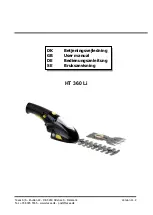
8
Unit Description
Figure 4
Front Handle
Safety Guard
Gearcase
Guide Bar
Cutter
Fuel Cap
Ignition Switch
Throttle
Lever
Scabbard
Air Cleaner
Cover
Fuel Tank
Choke
Front
Handle
Rear
Handle
Recoil
Starter
Throttle Lock
Button
Throttle
Lockout
Lever
Using Figure 4 as a guide, familiarize
yourself with this unit and its various
components. Understanding this unit
helps ensure top performance, long
service life, and safer operation.
WARNING!
Do not make unauthorized
modifications or alterations to this
unit or to any of its components or
accessories.
IMPORTANT!
The terms “left,” “left-hand,” and “LH”;
“right,” “right-hand,” and “RH”; “front”
and “rear” refer to directions as
viewed by the operator during normal
operation of this product.
DESCRIPTION
21
Long Term Storage
(30 days or longer)
CAUTION!
Never store this unit with any fuel
remaining in the tank, fuel lines or
carburetor!
NOTE:
Your Shindaiwa warranty does not
include coverage for damage caused
by stale or contaminated fuels.
■
Thoroughly clean the exterior of
the machine.
■
Remove all clippings and other
debris from the cylinder fins and
other components (as previously
described under Daily
Maintenance).
■
Drain all unused fuel from the fuel
tank, and then clear the carburetor
and fuel lines by running the
trimmer until it stops from lack of
fuel.
IMPORTANT!
All stored fuel should be stabilized
with fuel stabilizer such as STA-BIL™
■
Remove the spark plug, and pour
about 1/4 ounce of 2-cycle mixing
oil into the cylinder through the
spark plug hole. Before reinstalling
the spark plug, slowly pull the
recoil starter 2–3 times to distribute
the oil over the cylinder wall.
■
Service the air cleaner element as
previously described in the daily
maintenance section of this manual.
■
Repair or replace any damaged
components as required, and then
store the unit in a clean, dry, and
dust-free area.
22DH11
WARNING!
The cutter blades are very sharp!
Always wear gloves when working
around the cutter assembly!
CAUTION!
Operating the hedge trimmer with
worn or improperly adjusted
cutters will reduce cutter perfor-
mance and may also damage this
unit.
Cutter performance of this unit
depends in great measure on cutter
blade clearance. Properly adjusted
blades will oscillate freely yet help
prevent binding of cut material
between blades. Adjust blades as
follows (Figure 26):
1. Loosen all blade locknuts at least
one full turn.
2. Tighten each blade shoulder bolt
firmly, and then loosen the shoul-
der bolts 1/4 to 1/2 turn.
3. Working from the gearcase end,
lock each bolt in place by firmly
tightening its locknut while
preventing the shoulder bolt from
turning.
When shoulder bolt adjustment is
correct, there should be a gap of
0.025–0.050 mm between the cutter
blades and the flat washers, and the
flat washer beneath each bolt head
should turn freely.
Cutter Adjustment
Guide Bar
Locknut
Cutter Blades
Shoulder
Bolt
Washer
(should turn
freely)
Figure 26
MAINTENANCE
































